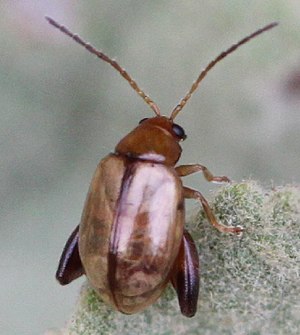Longitarsus tabidus
| Longitarsus tabidus | ||||||||||||
|---|---|---|---|---|---|---|---|---|---|---|---|---|

Longitarsus tabidus |
||||||||||||
| Systematics | ||||||||||||
|
||||||||||||
| Scientific name | ||||||||||||
| Longitarsus tabidus | ||||||||||||
| ( Fabricius , 1775) |
Longitarsus tabidus , German mullein earth flea , belongs to the flea beetles (tribe Alticini, subfamily Galerucinae) from the family of leaf beetles (Chrysomelidae).
features
The beetles are 3 to 4.5 millimeters in size. The basic color of the beetles is yellow-brown. The usually somewhat lighter elytra often have a dark hem along the seam. The slightly darker posterior femora are thickened, as in all flea beetles. The back rails have a long end pin. The species cannot be distinguished from numerous similar-looking representatives of the genus solely on the basis of its coloring.
The beetles usually have fully developed hind wings and are able to fly, but forms with shortened hind wings (brachyptere specimens) have also been described.
Way of life
The fleas can be found on meadows, on the edges of forests, in heathland and on sandy soils. You can find them as early as the second half of February under the basal rosette leaves of mullein. In particular, from April to November observing the Imagines . The species overwinters as an imago, possibly also as a larva and an egg. In Central Europe, adults are observed in spring when they leave their winter quarters. They lay eggs in spring, the larvae develop by summer, pupate and the new generation hatches in summer, so that the phenology shows a bimodal frequency curve. In Lithuania, adults were only observed from July to September. The adult beetles feed on the leaves and flowers, the larvae on the roots of mullein ( Verbascum ). When in danger, the beetles jump like fleas with the help of their strong hind legs.
Occurrence
The species occurs in the Palearctic . It is widespread in Europe and is also represented in the UK . In the south, their distribution area extends to North Africa. To the east it spreads over the Levant and Asia Minor, the Caucasus, Central and East Asia (Mongolia, China) to Japan. Individuals from Japan have been separated as the subspecies Longitarsus tabidus orientalis . There are a number of very similar and probably closely related species (the tabidus species group).
Taxonomy
The species was first described by Fabricius as Altica tabida . It belongs in the genus Longitarsus in the subgenus Longitarsus s.str .. A synonym is Longitarsus verbasci (Panzer, 1794).
Web links
Individual evidence
- ↑ a b c European beetles - Longitarsus . coleo-net.de. Retrieved November 29, 2017.
- ↑ a b c d e f g Longitarsus tabidus (Fabricius, 1775) . UK Beetle Recording. Retrieved November 29, 2017.
- ↑ David G. Furth (1980): Wing polymorphism, host plant ecology and biogeography of Longitarsus in Israel (Coleoptera, Chrysomelidae). Israel Journal of Entomology 13: 125-148.
- ^ Walter R. Steinhausen (2005): Phenology of Central European Leaf Flea Beetles (Coleoptera: Chrysomelidae: Alticini). Reports of the Natural Science-Medical Association Innsbruck 91: 221-232.
- ↑ Andris Bukejs (2010): To the knowledge of flea beetles (Coleoptera: Chrysomelidae: Alticinae) of the Latvian fauna. 6. genus Longitarsus Latreille, 1829. Acta Biologica Universitatis Daugavpiliensis 10 (1): 53-70.
- ^ Longitarsus tabidus (Fabricius, 1775) (a flea beetle) . bioinfo.org.uk. Retrieved November 29, 2017.
- ^ Longitarsus tabidus (Fabricius, 1775) . Fauna Europaea. Retrieved November 29, 2017.
- ↑ Andrzej Warchalowski (1970): Revision of the Chinese Longitarsus species (Coleoptera, Chrysomelidae). Annales Zoologici 28 (8): 98-152.
